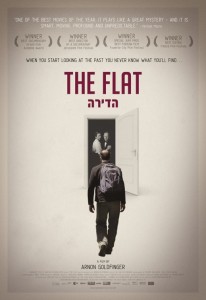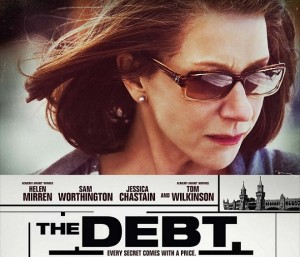Interview: Arnon Goldfinger of “The Flat”
Posted on November 1, 2012 at 8:00 am
After documentary filmmaker Arnon Goldfinger’s grandmother died at age 97 in Israel, he brought a film crew to her apartment where she and his grandfather lived from the time they immigrated to what was then called Palestine just before World War II. He was fascinated by their home, which seventy years later looked as though it had been transplanted from their birthplace in Germany. The books on the shelves were in German. They always spoke German in their home. Most of their lives were lived in Israel, but they lived as though they were still in Berlin.
Goldfinger thought he would learn something about his grandparents as the family sorted through their belongings. But he could never have imagined what he would find or where it would take him. His grandmother had saved issues of one of the most virulently anti-Semitic newspapers distributed in Nazi Germany. This discovery led to a journey that illuminated one of the strangest friendships imaginable, represented by an artifact that is almost unthinkable — a coin with a Jewish star on one side and a Nazi swastika on the other. The movie also focuses on the strain this inquiry put on Goldfinger’s relationship with his mother, who was almost as passionate about not finding out the answers to his questions as Goldfinger was about seeking them.
I spoke to Goldfinger when he was in Washington, D.C. to show the film, which opens tomorrow.
What did you think you were going to film?
To be honest, I just wanted to be there with the camera and document the world I knew was going to disappear very quickly. I thought it would be an even quicker process. I knew this flat all my life and I had an ambivalent feeling toward it. On the one hand, I had an attraction to this world, to this culture, to those books, to the secrets, the mystery. On the other hand, as an Israeli it was so foreign, so German, so connected to the tragic happenings in the Holocaust. It was only later I had an idea to make a film, but even then the idea was just something very short. People would ask, “What can you learn about someone from what they leave behind?” This shows you can learn a lot.
What does your mother think about the movie?
I was very afraid of course. Our relationship was close before and if it would stay like that, it would be fine. But I was surprised. It brought us closer. She was very supportive of the film. After the first screening, when she first saw it, she said she saw it was important for her, too. When her friends saw the film, they said to her, “We didn’t know, either. We didn’t ask.” She felt that she was not alone.
Why was your mother reluctant to know more?
She was really raised in a German house. I remember as a kid, hearing her argue with her parents in German. But when she went out of the flat, she was in Tel Aviv, the Mediterranean combined with bohemian, a place of vibrance. She lived two lives. But like all of the people of her age, she wanted to leave the past behind her, as you see when you look at her flat, not even any dust from the past. Your house is the place you want to live in. And she wanted to live with with barriers to all the historical items. Before I made the film I thought it was her character. But now I understand it’s a barrier from all the pain and sorrow.
You met with Edda, the daughter of the Nazi couple who were your grandparents’ friends. Tell me something about your impressions.
They were lovely people, very friendly, welcoming, warm. That made it harder. If they were nasty it would have been easier for me. During my research I would think, “Maybe it’s not possible, maybe it’s not right” that this friendship existed between my grandparents and the Nazis. If I called someone out of the blue and said “My grandparents knew your parents, I would not recognize one name.” But the way she recognized it so immediately, the way she knew and was so glad to hear from me in such an open way and with such memories — I don’t remember even one gift my parents’ friends gave me — but for her, she remembered so much.
What about her father, the man who was your grandparents’ friend while having an important role in the Nazi party?
I found much more about him than what is in the film. It was important to say that he did not live the Nazi party. He was involved in anti-Semitic propaganda. But he wanted to stay in contact with Jews. I found all kinds of other things about him, nothing that would change your mind, no smoking gun, but you could ask yourself, “Did he have an alternative?” The way to describe what happened was this. Nobody knew what Hitler wanted, but everybody knew if they did something Hitler did not want, it’s the end. It was a classic regime of terror. There’s a book called Alone in Berlin that described life in the war. It’s horrible. I am a Jew; I don’t so much identify with them, but still I can understand and ask the question, “Could he do something?” If you look at his career, you won’t find him in the concentration camps. He is in the headquarters, spying, thinking. For me, it’s enough.
One of the most shocking moments for me was when Edda told me that she knew my family had lost someone in the concentration camps. She did not have the details right. She thought it was my grandfather’s mother, not my grandmother’s mother. She’s a little mistaken with the details but it shows that she and therefore her parents knew some of what happened. That means my grandparents were sitting over there in the garden where we were, discussing the death of someone from their family with a man who was a Nazi. Did they ask him if he received their letter asking for help? Did he tell them he could not help them? There were a lot of lies over there.
My favorite character in the movie was your grandmother’s friend. What a beautiful face. I felt I knew your grandmother by seeing her friend.
She was my grandmother’s closest friend and like an aunt to me. When I first approached her, she did not want to be filmed. She was the only one, and I could not understand why. It took me almost a year to persuade her. But she said, “I will give you half an hour, but you come alone.” I told her I had to bring a cameraman and a sound man, and she said, “No, no, no.” In the end, it was only me and the cameraman. I figured she would see it is not threatening and she would let me stay longer. The cameraman said, “Be careful. Remember who you are dealing with. Ask the questions you want in the beginning not as usual at the end.” After 32 minutes she told me it is enough. Three months later she passed away. Her daughter was so happy that I captured her in her beauty. There’s such elegance in those characters.
Why did your grandmother keep the Der Angriff newspapers even though they were filled with anti-Semitic propaganda?
There was something emotional about it, a memory from a very, very important event in their life. The idea was to keep an eye on the Nazi and push him to include more Zionist material in his story. There may be a possibility my grandfather even edited the article. It was something very vivid at the time and maybe she forgot about it. She never opened it again. Maybe she forgot about it.
What are you going to do with them?
I think maybe give them to the Zionist archive in Jerusalem or to Yad Vashem.
Why does this movie touch people so deeply?
The film is telling an amazing story about a Nazi and a Jew, but really it is a movie about family, what you know about your family, what you want to know, what you can know. Those questions anyone can identify with, especially in America, a place of immigrants. Some people who see the movie tell me, “I want to ask my parents more about our history.” And some say, “I need to get rid of a lot of the things in my house!”



